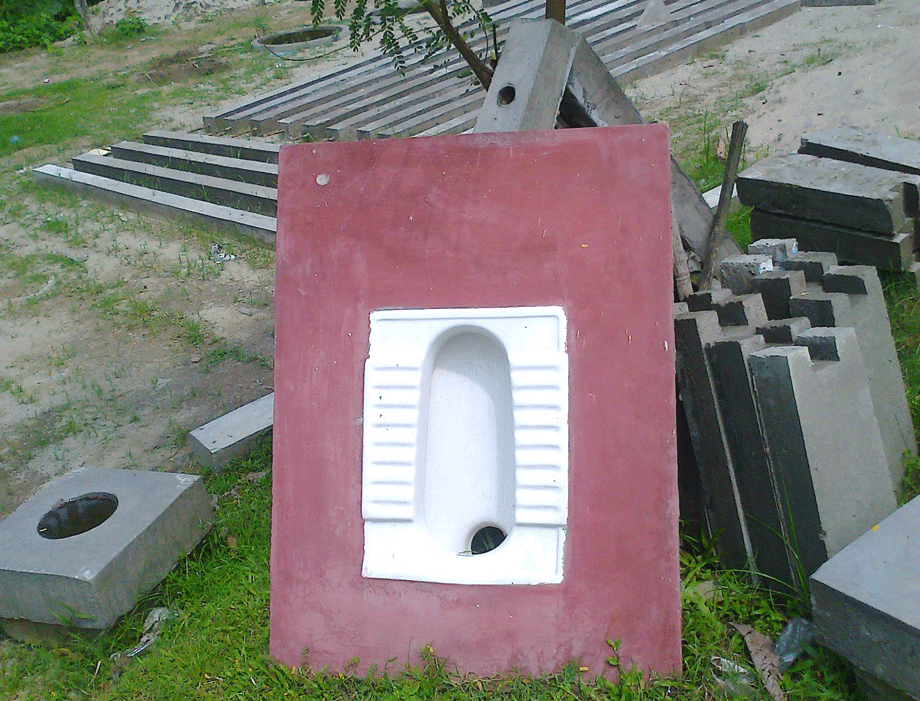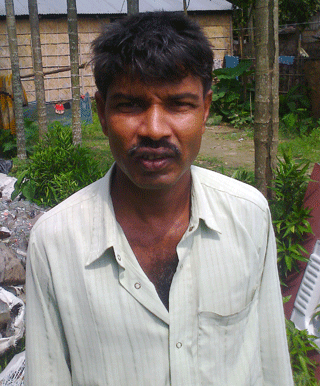A Crusader Of Rural Sanitation
By Sazzad Hussain
22 January, 2014
Countercurrents.org

His name is Ramzan Ali. A man in his early forties Ramzan Ali is like hundreds of roadside peasants that earn a living by selling their products by the National Highway-52 in agriculture rich Bechimari area of Darrang district of Assam. But unlike his fellow peasants, Ramzan does not sale the vegetables or other allied products on the roadside sheds. Unlike other peasants off NH-52, the front yard of Ramzan’s modest house is filled with heaps of plastic pipes, cement bags, pebbles and sands and his trade mark products—the floor sheet of Asian toilet sets. Ramzan buys Asian toilet seats made of ceramic and fits them in concrete sheets and sells them in reasonable prices to villagers to own a sanitary toilet. In this way, silently, away from the public health department’s schemes and campaigns, Ramzan has been transforming many villages by installing his cheap toilet sets, creating an environment of clean and hygienic atmosphere in one of the most backward regions of the state.
 Ramzan Ali’s this unique idea of making toilet sets came to his mind ten years ago when this ever innovative peasant decided to start some masonry work during the off season of agricultural activities. While making some sanitary toilets in some urban areas of Darrang district the unique idea came to his mind in making toilet sets and selling them to the rural population in cheaper rates. The entire population of several villages of Bechimari area under Lalpool Development Block and Lalpool GP of Darrang district are consisting of immigrant Muslims of East Bengali descent and are marginalized, like in other places of Assam, from the mainstream life. Predominantly associated with agricultural production, animal husbandry and fishery, these villagers lacked every civic amenity like pure drinking water, healthcare etc and sanitation was one aspect where the condition was very dismal. Significantly their religious adherence demanded better hygiene and sanitation standards for which they always looked for sanitary toilets, says Ramzan. As Islam demands strict personal hygiene and ‘purity’ for performance of Namaaz and other activities, these God-fearing village folks wanted a better system of toilet in their households. This is what Ramzan has been cashing in for rich harvests.
Ramzan Ali’s this unique idea of making toilet sets came to his mind ten years ago when this ever innovative peasant decided to start some masonry work during the off season of agricultural activities. While making some sanitary toilets in some urban areas of Darrang district the unique idea came to his mind in making toilet sets and selling them to the rural population in cheaper rates. The entire population of several villages of Bechimari area under Lalpool Development Block and Lalpool GP of Darrang district are consisting of immigrant Muslims of East Bengali descent and are marginalized, like in other places of Assam, from the mainstream life. Predominantly associated with agricultural production, animal husbandry and fishery, these villagers lacked every civic amenity like pure drinking water, healthcare etc and sanitation was one aspect where the condition was very dismal. Significantly their religious adherence demanded better hygiene and sanitation standards for which they always looked for sanitary toilets, says Ramzan. As Islam demands strict personal hygiene and ‘purity’ for performance of Namaaz and other activities, these God-fearing village folks wanted a better system of toilet in their households. This is what Ramzan has been cashing in for rich harvests.
Ten years ago Ramzan’s toilet set worth Rs. 300/- without pipes and other accessories. Presently his products cost Rs. 800/- to Rs. 900/-. With pipes and other accessories his entire set of sanitary toilet now costs Rs. 1100/-. The durability of his products also helps him to carry them to long distances in carts or any vehicles and people of even remote villages of this region can now have a complete sanitary toilet at the cost of Rs. 1000+. Though the state Public Health Engineering department has been distributing low cost sanitary toilets to the rural beneficiaries of BPL Card holders, Ramzan’s sets are still in demand as he fits readymade ceramic Asian toilet seats in his set.
Ramzan’s cheap sanitary toilet sets are brining revolutionary changes in rural India when about 638 million people, or more than half of those residing in the second-most populous nation on Earth, defecate in the open. On a planet where one in three doesn’t have access to proper sanitation, toilets are out of reach for 53 percent of India’s 1.2 billion residents left with little choice but to go outdoors, according to UNICEF. On 6th March, the WHO/UNICEF’s Joint Monitoring Programme on sanitation for Millenium Development Goal released its report on India which indicated that 59% (626 million) Indians still does not have access to toilets and they use open defecation. The Census-2011 gives another disturbing account of India on sanitation which says 53.1% (63.6% in 2001) households in India does not have a toilet. In the rural sector the percentage is 69.3% (78.1% in 2001) and in the urban areas it is 18.6% (26.3% in 2001). In Assam overall 35.1% (35.4% in 2001) households have no toilet. That means in the last ten years the governmental schemes could reach only 0.3% of the households. In this regard the very act by Ramzan in rural Assam is not but a crusading campaign. In rural Assam the picture is as same as in 2001 with 40.4% households with no toilet in 2011 Census. In the urban areas the state has 6.3% (5.4% in 2001) households with no toilet. Assam also has over all only 28.5% (15.9% in 2001) households have toilets with water closet (all India figure is 36.4% as against 18% in 2001), 34.7% (43.9% in 2001) households have pit latrines (all India 9.4% as against 11.5%) and 1.8% (4.3% in 2001) households have other types of toilet (all India 1.1% as against 6.9% in 2001). In the rural sector Assam has 20.6% (8.6% in 2001) households having toilets with water closet (all India 19.4% as against 7.1% in 2001), 37.2% (46.9% in 2001) households have pit latrines (all India 10.5% as against 10.3% in 2001) and 1.8% (4% in 2001) households have other toilets (all India 0.8% as against 4.5% in 2001). Similarly in the urban sector the state has an impressive development with 71% (58.9% in 2001) households having toilet with water closet (all India 72.6% as against 46% in 2001). In the pit latrine category Assam has urban households 21.01% (26.4% in 2001) where the national figure is 7.1% (14.6% in 2001). The state has 1.7% (9.3%) urban households with other toilets (all India 1.7% as against 13% in 2001 Census).
The most important part of Ramzan’s achievements is the participation of women in this concern. According to him, the women in the villages, who are otherwise very much subjugated to prevailing male dominated social system of the East Bengali Muslims of Assam, always took the initiatives in installing a sanitary toilet in their households. If some aid agencies, expert organizations come and train rural entrepreneurs like Ramzan, revolutionary changes would take place in rural Assam concerning sanitation and hygiene. This will also help in achieving Total Sanitation Campaign or Nirmal Gram Abhiyans in Assam.
(The writer is a fellow National Foundation of India, New Delhi).
Comments are moderated
